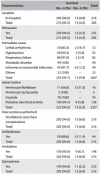Cohort study on the factors associated with survival post-cardiac arrest
- PMID: 26760123
- PMCID: PMC10496558
- DOI: 10.1590/1516-3180.2015.00472607
Cohort study on the factors associated with survival post-cardiac arrest
Abstract
Context and objective: Cardiac arrest is a common occurrence, and even with efficient emergency treatment, it is associated with a poor prognosis. Identification of predictors of survival after cardiopulmonary resuscitation may provide important information for the healthcare team and family. The aim of this study was to identify factors associated with the survival of patients treated for cardiac arrest, after a one-year follow-up period.
Design and setting: Prospective cohort study conducted in the emergency department of a Brazilian university hospital.
Methods: The inclusion criterion was that the patients presented cardiac arrest that was treated in the emergency department (n = 285). Data were collected using the In-hospital Utstein Style template. Cox regression was used to determine which variables were associated with the survival rate (with 95% significance level).
Results: After one year, the survival rate was low. Among the patients treated, 39.6% experienced a return of spontaneous circulation; 18.6% survived for 24 hours and of these, 5.6% were discharged and 4.5% were alive after one year of follow-up. Patients with pulseless electrical activity were half as likely to survive as patients with ventricular fibrillation. For patients with asystole, the survival rate was 3.5 times lower than that of patients with pulseless electrical activity.
Conclusions: The initial cardiac rhythm was the best predictor of patient survival. Compared with ventricular fibrillation, pulseless electrical activity was associated with shorter survival times. In turn, compared with pulseless electrical activity, asystole was associated with an even lower survival rate.
CONTEXTO E OBJETIVO:: A parada cardiorrespiratória é comum e, mesmo com tratamentos de emergência eficientes, associa-se a prognósticos ruins. A identificação de fatores preditores de sobrevivência após ressuscitação cardiopulmonar pode fornecer informações importantes para equipe de saúde e familiares. O objetivo deste estudo foi identificar fatores associados à sobrevivência, após um ano de seguimento, de pacientes atendidos em parada cardiorrespiratória.
DESENHO E LOCAL:: Estudo de coorte prospectivo realizado no serviço de emergência de um hospital universitário.
MÉTODOS:: O critério de inclusão foi o atendimento de paciente em parada cardiorrespiratória no serviço de emergência (n = 285). Os dados foram coletados por meio do modelo In-hospital Utstein Style. Para verificar quais variáveis associaram-se à sobrevida, utilizou-se regressão de Cox (nível de significância 95%).
RESULTADOS:: Após um ano, a sobrevida foi baixa. Dos pacientes atendidos, 39,6% tiveram retorno da circulação espontânea, 18,6% sobreviveram até as primeiras 24 horas, sendo que, destes, 5,6% obtiveram alta hospitalar e 4,5% permaneceram vivos após um ano de seguimento. Pacientes com atividade elétrica sem pulso apresentaram duas vezes menos chances de sobreviver que aqueles com fibrilação ventricular. Nos pacientes com assistolia, as taxas de sobrevida foram 3,5 menores quando comparados aos com atividade elétrica sem pulso.
CONCLUSÕES:: O ritmo cardíaco inicial foi o fator preditor que melhor explicou a sobrevida. O ritmo de atividade elétrica sem pulso associou-se a menor sobrevida quando comparado a fibrilação ventricular, enquanto o ritmo de assistolia relacionou-se a ainda menor sobrevivência em relação à atividade elétrica sem pulso.
Conflict of interest statement
Figures
Similar articles
-
A prospective investigation into the epidemiology of in-hospital pediatric cardiopulmonary resuscitation using the international Utstein reporting style.Pediatrics. 2002 Feb;109(2):200-9. doi: 10.1542/peds.109.2.200. Pediatrics. 2002. PMID: 11826196
-
Cardiopulmonary Resuscitation in an Average Brazilian Intensive Care Unit: Should We Perform Less or Better?Braz J Cardiovasc Surg. 2017 May-Jun;32(3):177-183. doi: 10.21470/1678-9741-2017-0036. Braz J Cardiovasc Surg. 2017. PMID: 28832795 Free PMC article.
-
First documented rhythm and clinical outcome from in-hospital cardiac arrest among children and adults.JAMA. 2006 Jan 4;295(1):50-7. doi: 10.1001/jama.295.1.50. JAMA. 2006. PMID: 16391216
-
In-Hospital Cardiac Arrest: An Update on Pulseless Electrical Activity and Asystole.Crit Care Nurs Clin North Am. 2016 Sep;28(3):387-97. doi: 10.1016/j.cnc.2016.04.010. Epub 2016 Jul 2. Crit Care Nurs Clin North Am. 2016. PMID: 27484665 Review.
-
Cardiopulmonary resuscitation in children.Curr Opin Crit Care. 2009 Jun;15(3):203-8. doi: 10.1097/mcc.0b013e32832931e1. Curr Opin Crit Care. 2009. PMID: 19469022 Review.
Cited by
-
Cardiopulmonary resuscitation of adults with in-hospital cardiac arrest using the Utstein style.Rev Bras Ter Intensiva. 2016 Oct-Dec;28(4):427-435. doi: 10.5935/0103-507X.20160076. Rev Bras Ter Intensiva. 2016. PMID: 28099640 Free PMC article.
-
Results of the implementation of integrated care after cardiorespiratory arrest in a university hospital.Rev Lat Am Enfermagem. 2018 Jul 16;26:e2993. doi: 10.1590/1518-8345.2308.2993. Rev Lat Am Enfermagem. 2018. PMID: 30020334 Free PMC article.
References
-
- Eng Hock Ong M, Chan YH, Anantharaman V, et al. Cardiac arrest and resuscitation epidemiology in Singapore(CARE I study) . Prehosp Emerg Care. 2003;7(4):427–433. - PubMed
-
- Tok D, Keles GT, Toprak V, Topcu I. Assessment of in-hospital cardiopulmonary resuscitation using Utstein template in a university hospital. Tohoku J Exp Med. 2004;202(4):265–273. - PubMed
-
- Peberdy MA, Kaye W, Ornato JP, et al. Cardiopulmonary resuscitation in adults in the hospital: a report of 14720 cardiac arrests from the National Registry of Cardiopulmonary Resuscitation. Resuscitation. 2003;58(3):297–308. - PubMed
-
- Phelps R, Dumas F, Maynard C, Silver J, Rea T. Cerebral Performance Category and long-term prognosis following out-of-hospital cardiac arrest. Crit Care Med. 2013;41(5):1252–1257. - PubMed
-
- Hospital São Paulo - Hospital universitário da UNIFESP . Quem somos. http://www.hospitalsaopaulo.org.br/quem-somos Accessed in 2015 (Aug 11)
MeSH terms
LinkOut - more resources
Full Text Sources
Medical




